HRM Report: Analysis of Iceland Foods LTD Human Resource Practices
VerifiedAdded on 2020/01/15
|18
|5642
|276
Report
AI Summary
This report provides a comprehensive analysis of Human Resource Management (HRM) practices at Iceland Foods LTD. It begins with an introduction to HRM and its importance, followed by an examination of the Guest model and its dimensions in relation to Iceland Foods. The report then compares HRM, Industrial Relations, and Personnel Management practices, highlighting the differences between Iceland Foods LTD and Primark. It further explores the implications for line managers and staff members, emphasizing the importance of strategic approaches. The report delves into the concept of flexibility in the workplace, discussing the Atkinson flexible firm model and its application within Iceland Foods LTD. Various types of flexibility, such as time, functional, numerical, and financial, are examined. The report also addresses the benefits of these flexible options. The report concludes with a discussion of the implications of HRM practices and strategies for the overall success of Iceland Foods LTD. The report includes references to support the analysis and findings.
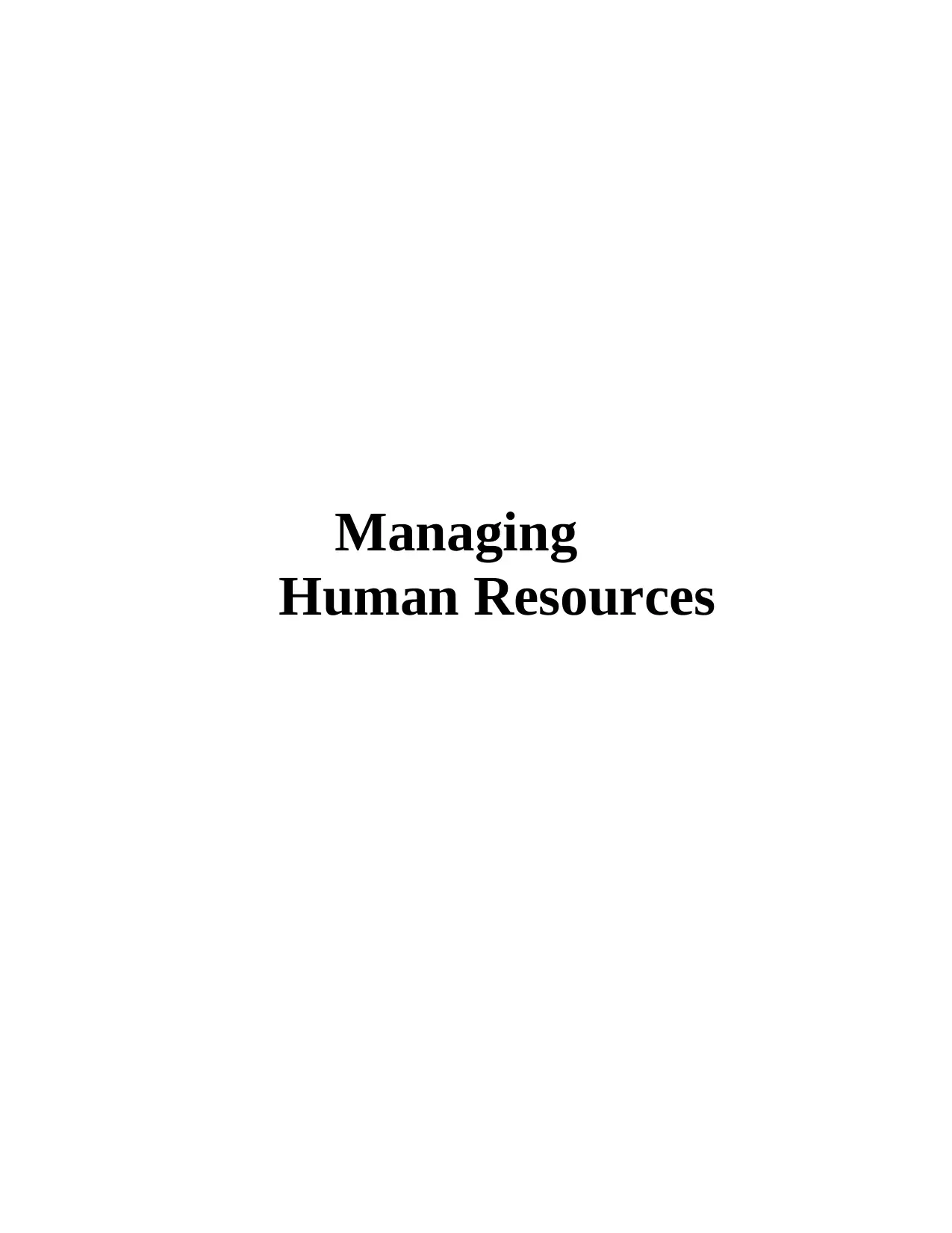
Managing
Human Resources
Human Resources
Paraphrase This Document
Need a fresh take? Get an instant paraphrase of this document with our AI Paraphraser

Table of Contents
INTRODUCTION............................................................................................................................3
TASK 1............................................................................................................................................3
1.1................................................................................................................................................3
1.2................................................................................................................................................4
1.3................................................................................................................................................5
TASK 2............................................................................................................................................6
2.1................................................................................................................................................6
2.2................................................................................................................................................7
2.3................................................................................................................................................8
2.4................................................................................................................................................9
TASK 3..........................................................................................................................................10
3.1..............................................................................................................................................10
3.2..............................................................................................................................................11
3.3..............................................................................................................................................12
TASK 4..........................................................................................................................................13
4.1..............................................................................................................................................13
4.2..............................................................................................................................................14
4.3..............................................................................................................................................15
4.4..............................................................................................................................................15
CONCLUSION..............................................................................................................................16
REFRENCES.................................................................................................................................18
INTRODUCTION............................................................................................................................3
TASK 1............................................................................................................................................3
1.1................................................................................................................................................3
1.2................................................................................................................................................4
1.3................................................................................................................................................5
TASK 2............................................................................................................................................6
2.1................................................................................................................................................6
2.2................................................................................................................................................7
2.3................................................................................................................................................8
2.4................................................................................................................................................9
TASK 3..........................................................................................................................................10
3.1..............................................................................................................................................10
3.2..............................................................................................................................................11
3.3..............................................................................................................................................12
TASK 4..........................................................................................................................................13
4.1..............................................................................................................................................13
4.2..............................................................................................................................................14
4.3..............................................................................................................................................15
4.4..............................................................................................................................................15
CONCLUSION..............................................................................................................................16
REFRENCES.................................................................................................................................18
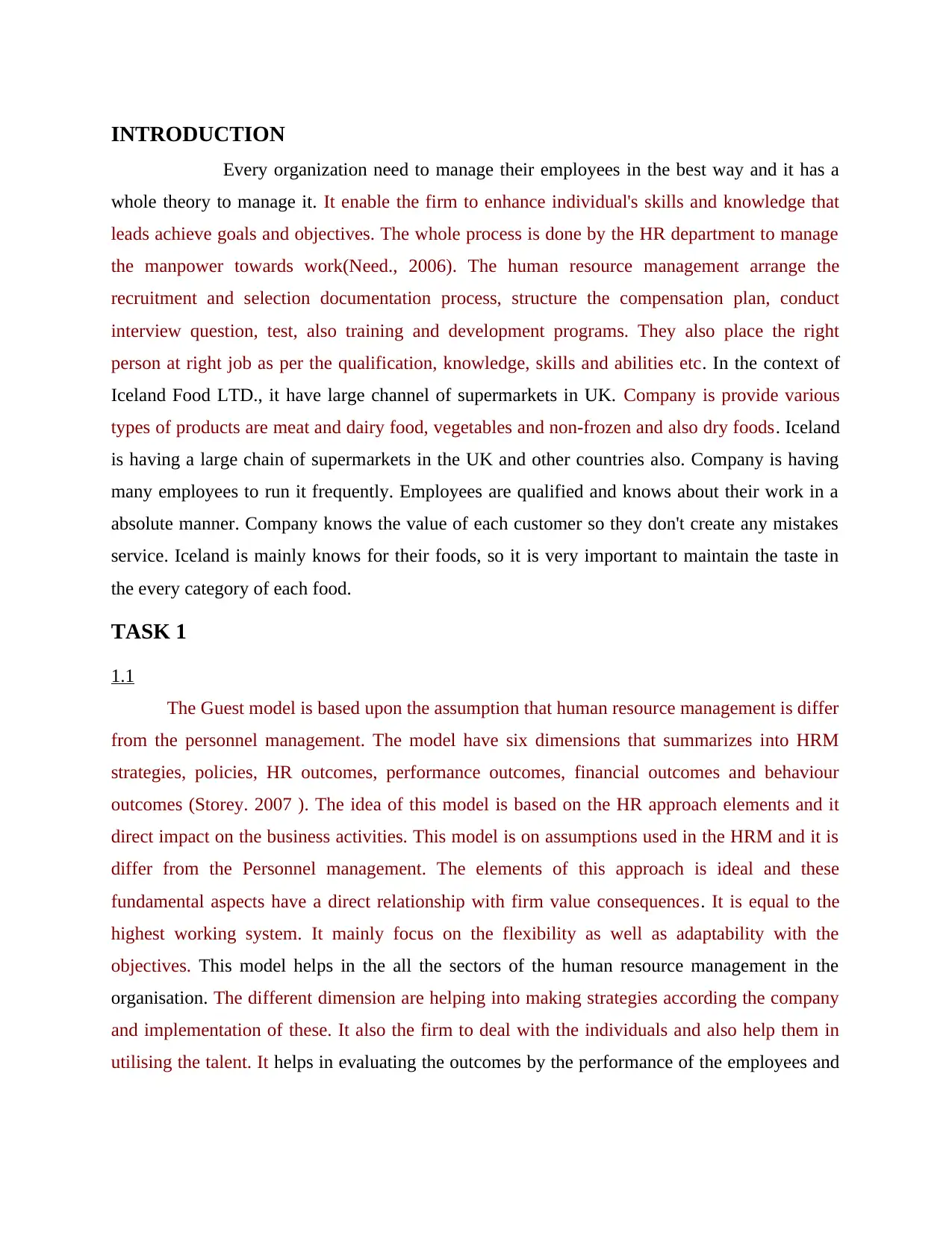
INTRODUCTION
Every organization need to manage their employees in the best way and it has a
whole theory to manage it. It enable the firm to enhance individual's skills and knowledge that
leads achieve goals and objectives. The whole process is done by the HR department to manage
the manpower towards work(Need., 2006). The human resource management arrange the
recruitment and selection documentation process, structure the compensation plan, conduct
interview question, test, also training and development programs. They also place the right
person at right job as per the qualification, knowledge, skills and abilities etc. In the context of
Iceland Food LTD., it have large channel of supermarkets in UK. Company is provide various
types of products are meat and dairy food, vegetables and non-frozen and also dry foods. Iceland
is having a large chain of supermarkets in the UK and other countries also. Company is having
many employees to run it frequently. Employees are qualified and knows about their work in a
absolute manner. Company knows the value of each customer so they don't create any mistakes
service. Iceland is mainly knows for their foods, so it is very important to maintain the taste in
the every category of each food.
TASK 1
1.1
The Guest model is based upon the assumption that human resource management is differ
from the personnel management. The model have six dimensions that summarizes into HRM
strategies, policies, HR outcomes, performance outcomes, financial outcomes and behaviour
outcomes (Storey. 2007 ). The idea of this model is based on the HR approach elements and it
direct impact on the business activities. This model is on assumptions used in the HRM and it is
differ from the Personnel management. The elements of this approach is ideal and these
fundamental aspects have a direct relationship with firm value consequences. It is equal to the
highest working system. It mainly focus on the flexibility as well as adaptability with the
objectives. This model helps in the all the sectors of the human resource management in the
organisation. The different dimension are helping into making strategies according the company
and implementation of these. It also the firm to deal with the individuals and also help them in
utilising the talent. It helps in evaluating the outcomes by the performance of the employees and
Every organization need to manage their employees in the best way and it has a
whole theory to manage it. It enable the firm to enhance individual's skills and knowledge that
leads achieve goals and objectives. The whole process is done by the HR department to manage
the manpower towards work(Need., 2006). The human resource management arrange the
recruitment and selection documentation process, structure the compensation plan, conduct
interview question, test, also training and development programs. They also place the right
person at right job as per the qualification, knowledge, skills and abilities etc. In the context of
Iceland Food LTD., it have large channel of supermarkets in UK. Company is provide various
types of products are meat and dairy food, vegetables and non-frozen and also dry foods. Iceland
is having a large chain of supermarkets in the UK and other countries also. Company is having
many employees to run it frequently. Employees are qualified and knows about their work in a
absolute manner. Company knows the value of each customer so they don't create any mistakes
service. Iceland is mainly knows for their foods, so it is very important to maintain the taste in
the every category of each food.
TASK 1
1.1
The Guest model is based upon the assumption that human resource management is differ
from the personnel management. The model have six dimensions that summarizes into HRM
strategies, policies, HR outcomes, performance outcomes, financial outcomes and behaviour
outcomes (Storey. 2007 ). The idea of this model is based on the HR approach elements and it
direct impact on the business activities. This model is on assumptions used in the HRM and it is
differ from the Personnel management. The elements of this approach is ideal and these
fundamental aspects have a direct relationship with firm value consequences. It is equal to the
highest working system. It mainly focus on the flexibility as well as adaptability with the
objectives. This model helps in the all the sectors of the human resource management in the
organisation. The different dimension are helping into making strategies according the company
and implementation of these. It also the firm to deal with the individuals and also help them in
utilising the talent. It helps in evaluating the outcomes by the performance of the employees and
⊘ This is a preview!⊘
Do you want full access?
Subscribe today to unlock all pages.

Trusted by 1+ million students worldwide
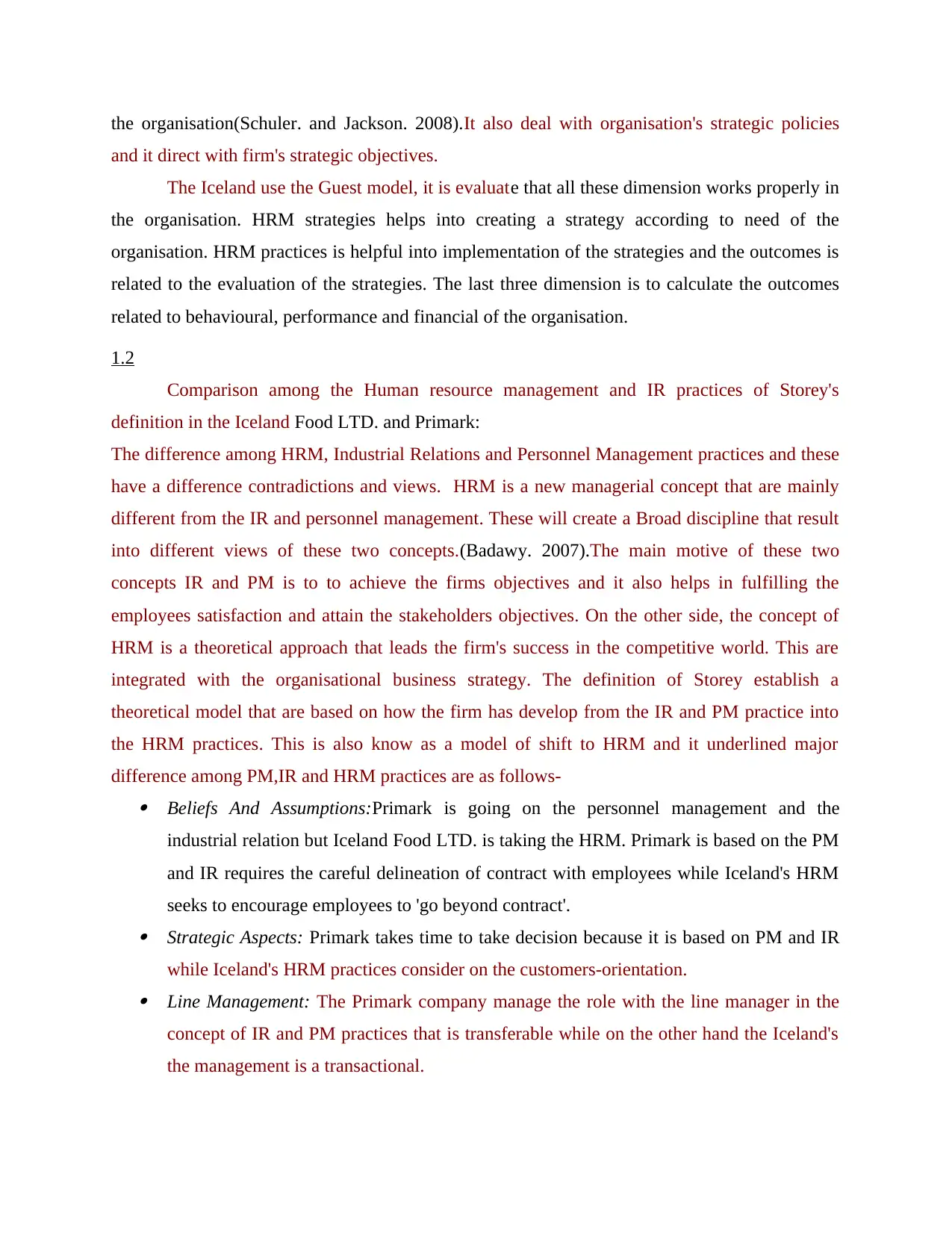
the organisation(Schuler. and Jackson. 2008).It also deal with organisation's strategic policies
and it direct with firm's strategic objectives.
The Iceland use the Guest model, it is evaluate that all these dimension works properly in
the organisation. HRM strategies helps into creating a strategy according to need of the
organisation. HRM practices is helpful into implementation of the strategies and the outcomes is
related to the evaluation of the strategies. The last three dimension is to calculate the outcomes
related to behavioural, performance and financial of the organisation.
1.2
Comparison among the Human resource management and IR practices of Storey's
definition in the Iceland Food LTD. and Primark:
The difference among HRM, Industrial Relations and Personnel Management practices and these
have a difference contradictions and views. HRM is a new managerial concept that are mainly
different from the IR and personnel management. These will create a Broad discipline that result
into different views of these two concepts.(Badawy. 2007).The main motive of these two
concepts IR and PM is to to achieve the firms objectives and it also helps in fulfilling the
employees satisfaction and attain the stakeholders objectives. On the other side, the concept of
HRM is a theoretical approach that leads the firm's success in the competitive world. This are
integrated with the organisational business strategy. The definition of Storey establish a
theoretical model that are based on how the firm has develop from the IR and PM practice into
the HRM practices. This is also know as a model of shift to HRM and it underlined major
difference among PM,IR and HRM practices are as follows- Beliefs And Assumptions:Primark is going on the personnel management and the
industrial relation but Iceland Food LTD. is taking the HRM. Primark is based on the PM
and IR requires the careful delineation of contract with employees while Iceland's HRM
seeks to encourage employees to 'go beyond contract'. Strategic Aspects: Primark takes time to take decision because it is based on PM and IR
while Iceland's HRM practices consider on the customers-orientation. Line Management: The Primark company manage the role with the line manager in the
concept of IR and PM practices that is transferable while on the other hand the Iceland's
the management is a transactional.
and it direct with firm's strategic objectives.
The Iceland use the Guest model, it is evaluate that all these dimension works properly in
the organisation. HRM strategies helps into creating a strategy according to need of the
organisation. HRM practices is helpful into implementation of the strategies and the outcomes is
related to the evaluation of the strategies. The last three dimension is to calculate the outcomes
related to behavioural, performance and financial of the organisation.
1.2
Comparison among the Human resource management and IR practices of Storey's
definition in the Iceland Food LTD. and Primark:
The difference among HRM, Industrial Relations and Personnel Management practices and these
have a difference contradictions and views. HRM is a new managerial concept that are mainly
different from the IR and personnel management. These will create a Broad discipline that result
into different views of these two concepts.(Badawy. 2007).The main motive of these two
concepts IR and PM is to to achieve the firms objectives and it also helps in fulfilling the
employees satisfaction and attain the stakeholders objectives. On the other side, the concept of
HRM is a theoretical approach that leads the firm's success in the competitive world. This are
integrated with the organisational business strategy. The definition of Storey establish a
theoretical model that are based on how the firm has develop from the IR and PM practice into
the HRM practices. This is also know as a model of shift to HRM and it underlined major
difference among PM,IR and HRM practices are as follows- Beliefs And Assumptions:Primark is going on the personnel management and the
industrial relation but Iceland Food LTD. is taking the HRM. Primark is based on the PM
and IR requires the careful delineation of contract with employees while Iceland's HRM
seeks to encourage employees to 'go beyond contract'. Strategic Aspects: Primark takes time to take decision because it is based on PM and IR
while Iceland's HRM practices consider on the customers-orientation. Line Management: The Primark company manage the role with the line manager in the
concept of IR and PM practices that is transferable while on the other hand the Iceland's
the management is a transactional.
Paraphrase This Document
Need a fresh take? Get an instant paraphrase of this document with our AI Paraphraser
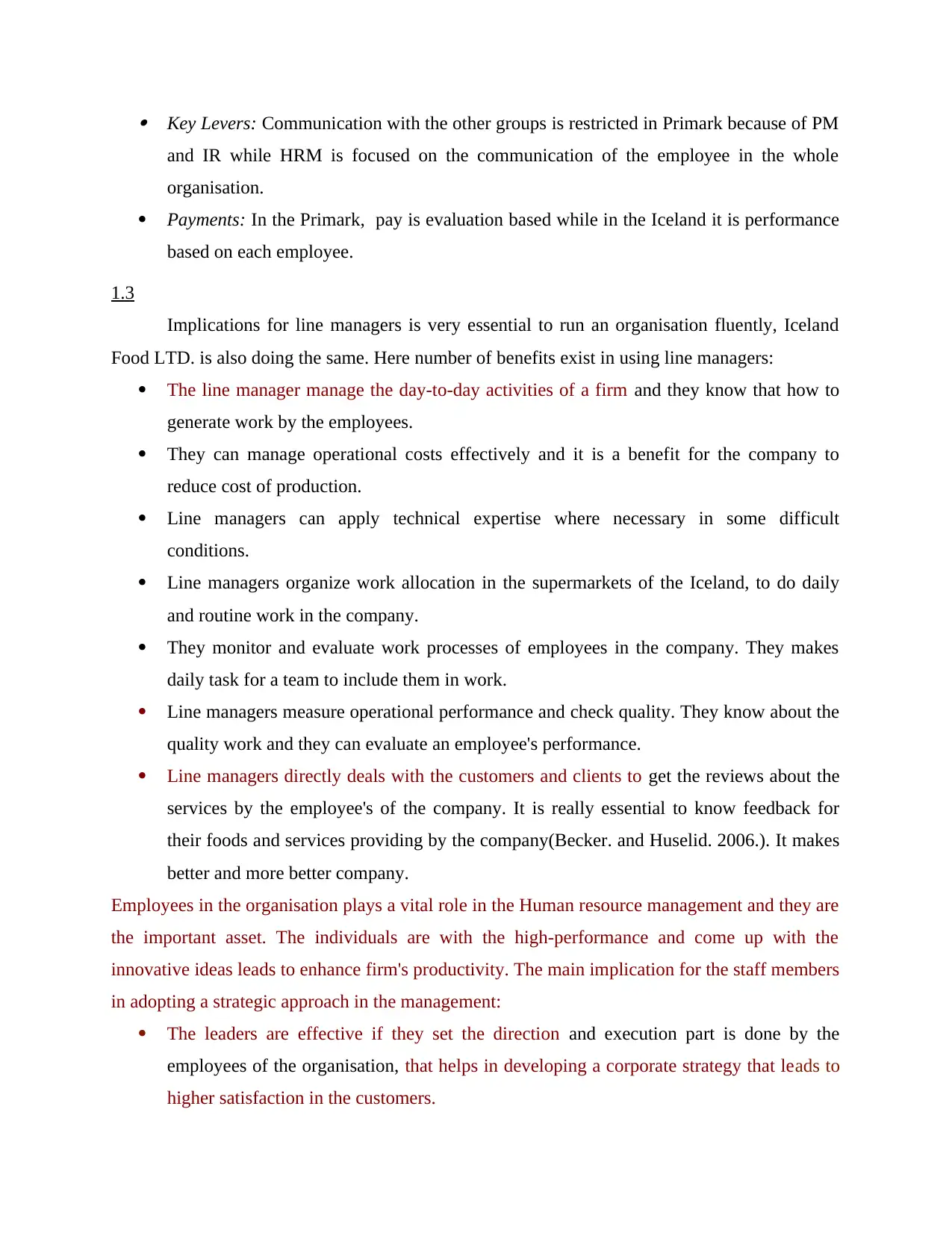
Key Levers: Communication with the other groups is restricted in Primark because of PM
and IR while HRM is focused on the communication of the employee in the whole
organisation.
Payments: In the Primark, pay is evaluation based while in the Iceland it is performance
based on each employee.
1.3
Implications for line managers is very essential to run an organisation fluently, Iceland
Food LTD. is also doing the same. Here number of benefits exist in using line managers:
The line manager manage the day-to-day activities of a firm and they know that how to
generate work by the employees.
They can manage operational costs effectively and it is a benefit for the company to
reduce cost of production.
Line managers can apply technical expertise where necessary in some difficult
conditions.
Line managers organize work allocation in the supermarkets of the Iceland, to do daily
and routine work in the company.
They monitor and evaluate work processes of employees in the company. They makes
daily task for a team to include them in work.
Line managers measure operational performance and check quality. They know about the
quality work and they can evaluate an employee's performance.
Line managers directly deals with the customers and clients to get the reviews about the
services by the employee's of the company. It is really essential to know feedback for
their foods and services providing by the company(Becker. and Huselid. 2006.). It makes
better and more better company.
Employees in the organisation plays a vital role in the Human resource management and they are
the important asset. The individuals are with the high-performance and come up with the
innovative ideas leads to enhance firm's productivity. The main implication for the staff members
in adopting a strategic approach in the management:
The leaders are effective if they set the direction and execution part is done by the
employees of the organisation, that helps in developing a corporate strategy that leads to
higher satisfaction in the customers.
and IR while HRM is focused on the communication of the employee in the whole
organisation.
Payments: In the Primark, pay is evaluation based while in the Iceland it is performance
based on each employee.
1.3
Implications for line managers is very essential to run an organisation fluently, Iceland
Food LTD. is also doing the same. Here number of benefits exist in using line managers:
The line manager manage the day-to-day activities of a firm and they know that how to
generate work by the employees.
They can manage operational costs effectively and it is a benefit for the company to
reduce cost of production.
Line managers can apply technical expertise where necessary in some difficult
conditions.
Line managers organize work allocation in the supermarkets of the Iceland, to do daily
and routine work in the company.
They monitor and evaluate work processes of employees in the company. They makes
daily task for a team to include them in work.
Line managers measure operational performance and check quality. They know about the
quality work and they can evaluate an employee's performance.
Line managers directly deals with the customers and clients to get the reviews about the
services by the employee's of the company. It is really essential to know feedback for
their foods and services providing by the company(Becker. and Huselid. 2006.). It makes
better and more better company.
Employees in the organisation plays a vital role in the Human resource management and they are
the important asset. The individuals are with the high-performance and come up with the
innovative ideas leads to enhance firm's productivity. The main implication for the staff members
in adopting a strategic approach in the management:
The leaders are effective if they set the direction and execution part is done by the
employees of the organisation, that helps in developing a corporate strategy that leads to
higher satisfaction in the customers.
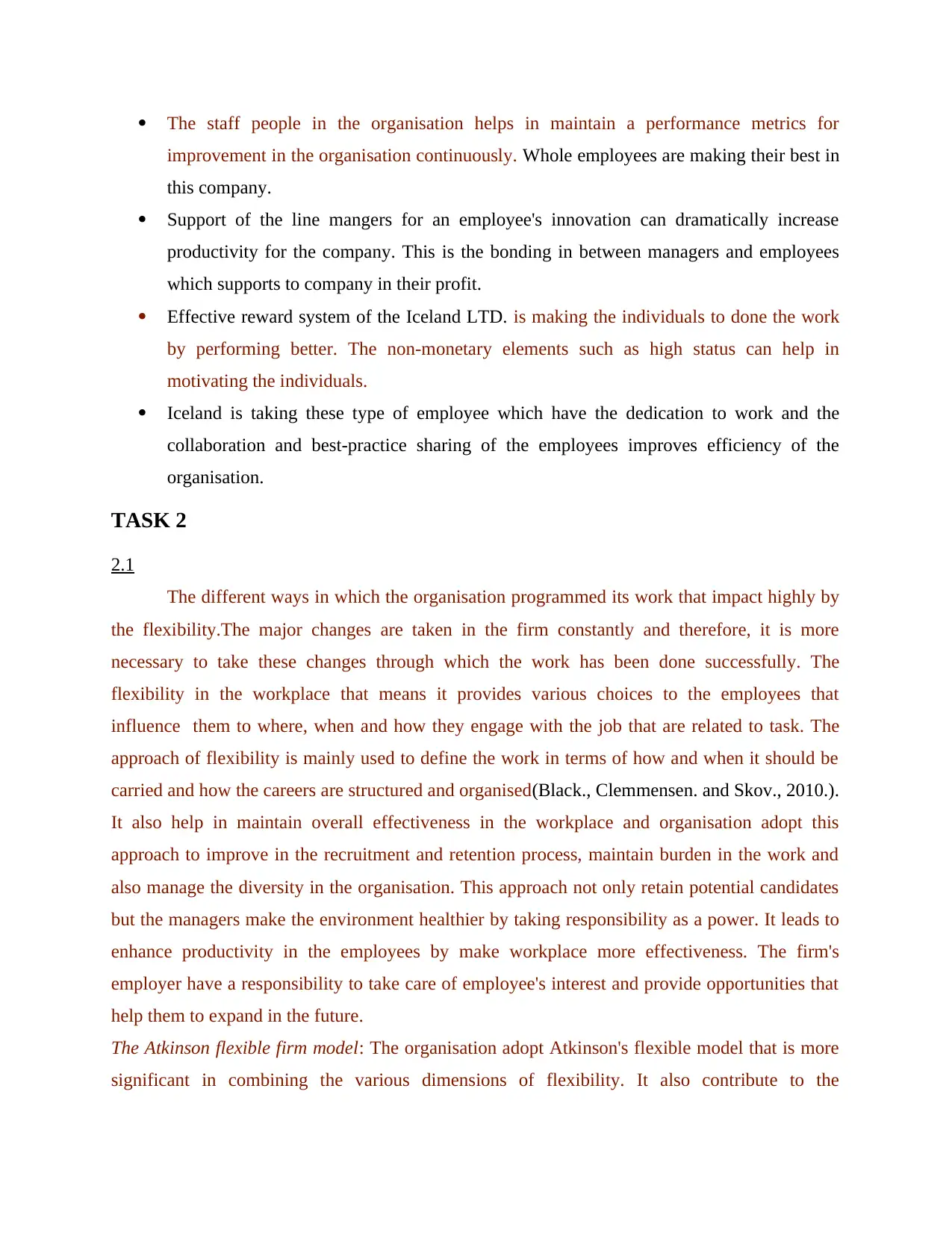
The staff people in the organisation helps in maintain a performance metrics for
improvement in the organisation continuously. Whole employees are making their best in
this company.
Support of the line mangers for an employee's innovation can dramatically increase
productivity for the company. This is the bonding in between managers and employees
which supports to company in their profit.
Effective reward system of the Iceland LTD. is making the individuals to done the work
by performing better. The non-monetary elements such as high status can help in
motivating the individuals.
Iceland is taking these type of employee which have the dedication to work and the
collaboration and best-practice sharing of the employees improves efficiency of the
organisation.
TASK 2
2.1
The different ways in which the organisation programmed its work that impact highly by
the flexibility.The major changes are taken in the firm constantly and therefore, it is more
necessary to take these changes through which the work has been done successfully. The
flexibility in the workplace that means it provides various choices to the employees that
influence them to where, when and how they engage with the job that are related to task. The
approach of flexibility is mainly used to define the work in terms of how and when it should be
carried and how the careers are structured and organised(Black., Clemmensen. and Skov., 2010.).
It also help in maintain overall effectiveness in the workplace and organisation adopt this
approach to improve in the recruitment and retention process, maintain burden in the work and
also manage the diversity in the organisation. This approach not only retain potential candidates
but the managers make the environment healthier by taking responsibility as a power. It leads to
enhance productivity in the employees by make workplace more effectiveness. The firm's
employer have a responsibility to take care of employee's interest and provide opportunities that
help them to expand in the future.
The Atkinson flexible firm model: The organisation adopt Atkinson's flexible model that is more
significant in combining the various dimensions of flexibility. It also contribute to the
improvement in the organisation continuously. Whole employees are making their best in
this company.
Support of the line mangers for an employee's innovation can dramatically increase
productivity for the company. This is the bonding in between managers and employees
which supports to company in their profit.
Effective reward system of the Iceland LTD. is making the individuals to done the work
by performing better. The non-monetary elements such as high status can help in
motivating the individuals.
Iceland is taking these type of employee which have the dedication to work and the
collaboration and best-practice sharing of the employees improves efficiency of the
organisation.
TASK 2
2.1
The different ways in which the organisation programmed its work that impact highly by
the flexibility.The major changes are taken in the firm constantly and therefore, it is more
necessary to take these changes through which the work has been done successfully. The
flexibility in the workplace that means it provides various choices to the employees that
influence them to where, when and how they engage with the job that are related to task. The
approach of flexibility is mainly used to define the work in terms of how and when it should be
carried and how the careers are structured and organised(Black., Clemmensen. and Skov., 2010.).
It also help in maintain overall effectiveness in the workplace and organisation adopt this
approach to improve in the recruitment and retention process, maintain burden in the work and
also manage the diversity in the organisation. This approach not only retain potential candidates
but the managers make the environment healthier by taking responsibility as a power. It leads to
enhance productivity in the employees by make workplace more effectiveness. The firm's
employer have a responsibility to take care of employee's interest and provide opportunities that
help them to expand in the future.
The Atkinson flexible firm model: The organisation adopt Atkinson's flexible model that is more
significant in combining the various dimensions of flexibility. It also contribute to the
⊘ This is a preview!⊘
Do you want full access?
Subscribe today to unlock all pages.

Trusted by 1+ million students worldwide
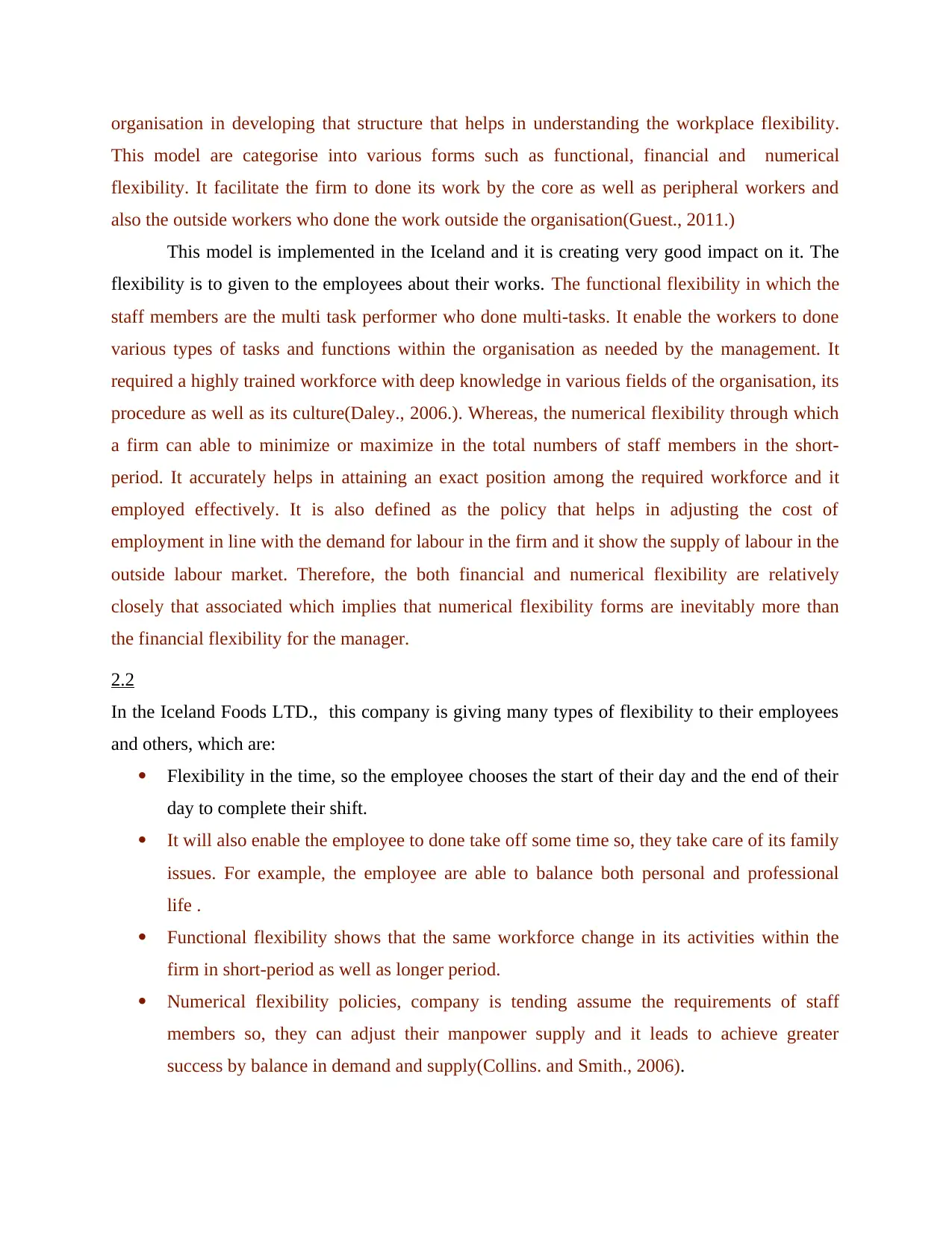
organisation in developing that structure that helps in understanding the workplace flexibility.
This model are categorise into various forms such as functional, financial and numerical
flexibility. It facilitate the firm to done its work by the core as well as peripheral workers and
also the outside workers who done the work outside the organisation(Guest., 2011.)
This model is implemented in the Iceland and it is creating very good impact on it. The
flexibility is to given to the employees about their works. The functional flexibility in which the
staff members are the multi task performer who done multi-tasks. It enable the workers to done
various types of tasks and functions within the organisation as needed by the management. It
required a highly trained workforce with deep knowledge in various fields of the organisation, its
procedure as well as its culture(Daley., 2006.). Whereas, the numerical flexibility through which
a firm can able to minimize or maximize in the total numbers of staff members in the short-
period. It accurately helps in attaining an exact position among the required workforce and it
employed effectively. It is also defined as the policy that helps in adjusting the cost of
employment in line with the demand for labour in the firm and it show the supply of labour in the
outside labour market. Therefore, the both financial and numerical flexibility are relatively
closely that associated which implies that numerical flexibility forms are inevitably more than
the financial flexibility for the manager.
2.2
In the Iceland Foods LTD., this company is giving many types of flexibility to their employees
and others, which are:
Flexibility in the time, so the employee chooses the start of their day and the end of their
day to complete their shift.
It will also enable the employee to done take off some time so, they take care of its family
issues. For example, the employee are able to balance both personal and professional
life .
Functional flexibility shows that the same workforce change in its activities within the
firm in short-period as well as longer period.
Numerical flexibility policies, company is tending assume the requirements of staff
members so, they can adjust their manpower supply and it leads to achieve greater
success by balance in demand and supply(Collins. and Smith., 2006).
This model are categorise into various forms such as functional, financial and numerical
flexibility. It facilitate the firm to done its work by the core as well as peripheral workers and
also the outside workers who done the work outside the organisation(Guest., 2011.)
This model is implemented in the Iceland and it is creating very good impact on it. The
flexibility is to given to the employees about their works. The functional flexibility in which the
staff members are the multi task performer who done multi-tasks. It enable the workers to done
various types of tasks and functions within the organisation as needed by the management. It
required a highly trained workforce with deep knowledge in various fields of the organisation, its
procedure as well as its culture(Daley., 2006.). Whereas, the numerical flexibility through which
a firm can able to minimize or maximize in the total numbers of staff members in the short-
period. It accurately helps in attaining an exact position among the required workforce and it
employed effectively. It is also defined as the policy that helps in adjusting the cost of
employment in line with the demand for labour in the firm and it show the supply of labour in the
outside labour market. Therefore, the both financial and numerical flexibility are relatively
closely that associated which implies that numerical flexibility forms are inevitably more than
the financial flexibility for the manager.
2.2
In the Iceland Foods LTD., this company is giving many types of flexibility to their employees
and others, which are:
Flexibility in the time, so the employee chooses the start of their day and the end of their
day to complete their shift.
It will also enable the employee to done take off some time so, they take care of its family
issues. For example, the employee are able to balance both personal and professional
life .
Functional flexibility shows that the same workforce change in its activities within the
firm in short-period as well as longer period.
Numerical flexibility policies, company is tending assume the requirements of staff
members so, they can adjust their manpower supply and it leads to achieve greater
success by balance in demand and supply(Collins. and Smith., 2006).
Paraphrase This Document
Need a fresh take? Get an instant paraphrase of this document with our AI Paraphraser
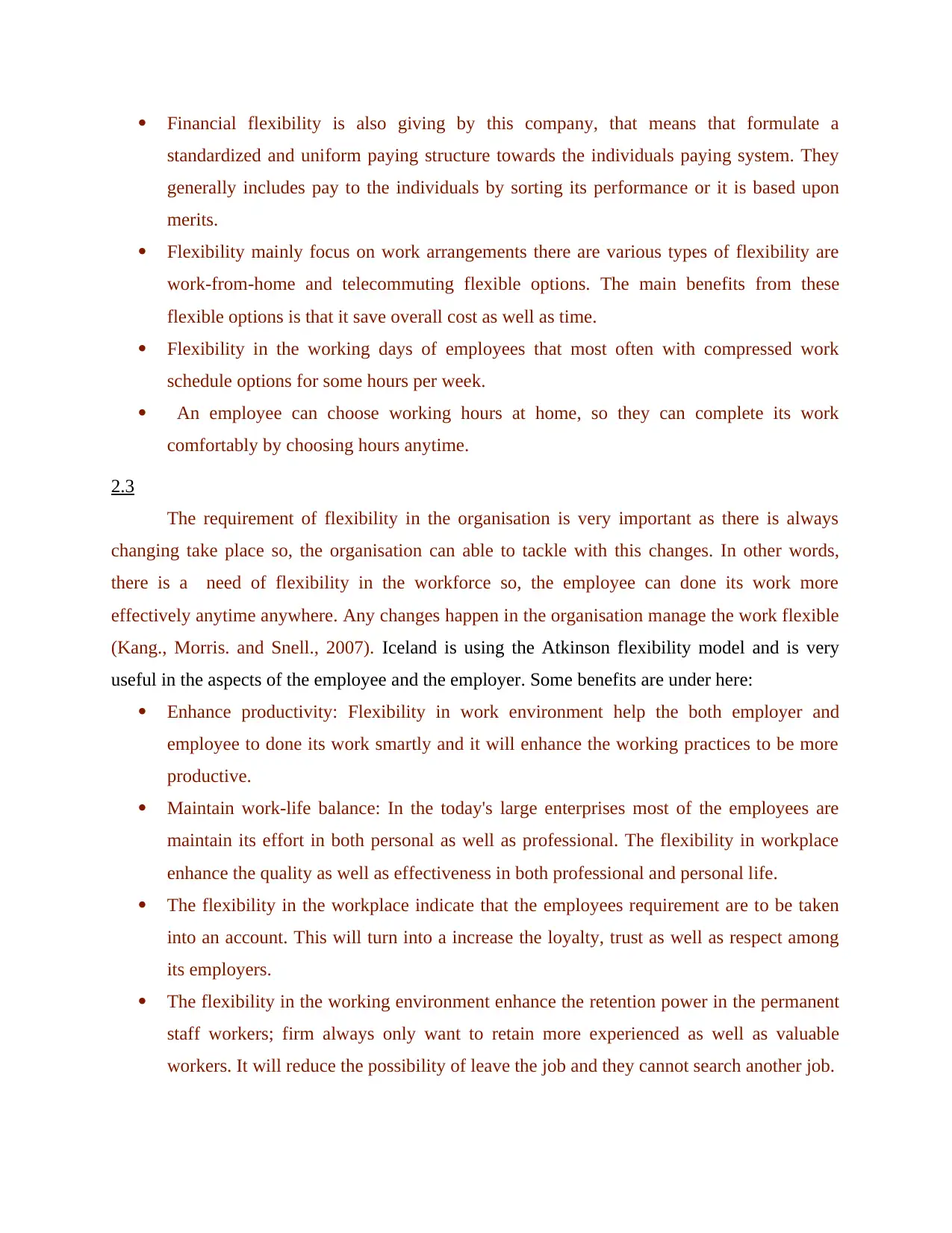
Financial flexibility is also giving by this company, that means that formulate a
standardized and uniform paying structure towards the individuals paying system. They
generally includes pay to the individuals by sorting its performance or it is based upon
merits.
Flexibility mainly focus on work arrangements there are various types of flexibility are
work-from-home and telecommuting flexible options. The main benefits from these
flexible options is that it save overall cost as well as time.
Flexibility in the working days of employees that most often with compressed work
schedule options for some hours per week.
An employee can choose working hours at home, so they can complete its work
comfortably by choosing hours anytime.
2.3
The requirement of flexibility in the organisation is very important as there is always
changing take place so, the organisation can able to tackle with this changes. In other words,
there is a need of flexibility in the workforce so, the employee can done its work more
effectively anytime anywhere. Any changes happen in the organisation manage the work flexible
(Kang., Morris. and Snell., 2007). Iceland is using the Atkinson flexibility model and is very
useful in the aspects of the employee and the employer. Some benefits are under here:
Enhance productivity: Flexibility in work environment help the both employer and
employee to done its work smartly and it will enhance the working practices to be more
productive.
Maintain work-life balance: In the today's large enterprises most of the employees are
maintain its effort in both personal as well as professional. The flexibility in workplace
enhance the quality as well as effectiveness in both professional and personal life.
The flexibility in the workplace indicate that the employees requirement are to be taken
into an account. This will turn into a increase the loyalty, trust as well as respect among
its employers.
The flexibility in the working environment enhance the retention power in the permanent
staff workers; firm always only want to retain more experienced as well as valuable
workers. It will reduce the possibility of leave the job and they cannot search another job.
standardized and uniform paying structure towards the individuals paying system. They
generally includes pay to the individuals by sorting its performance or it is based upon
merits.
Flexibility mainly focus on work arrangements there are various types of flexibility are
work-from-home and telecommuting flexible options. The main benefits from these
flexible options is that it save overall cost as well as time.
Flexibility in the working days of employees that most often with compressed work
schedule options for some hours per week.
An employee can choose working hours at home, so they can complete its work
comfortably by choosing hours anytime.
2.3
The requirement of flexibility in the organisation is very important as there is always
changing take place so, the organisation can able to tackle with this changes. In other words,
there is a need of flexibility in the workforce so, the employee can done its work more
effectively anytime anywhere. Any changes happen in the organisation manage the work flexible
(Kang., Morris. and Snell., 2007). Iceland is using the Atkinson flexibility model and is very
useful in the aspects of the employee and the employer. Some benefits are under here:
Enhance productivity: Flexibility in work environment help the both employer and
employee to done its work smartly and it will enhance the working practices to be more
productive.
Maintain work-life balance: In the today's large enterprises most of the employees are
maintain its effort in both personal as well as professional. The flexibility in workplace
enhance the quality as well as effectiveness in both professional and personal life.
The flexibility in the workplace indicate that the employees requirement are to be taken
into an account. This will turn into a increase the loyalty, trust as well as respect among
its employers.
The flexibility in the working environment enhance the retention power in the permanent
staff workers; firm always only want to retain more experienced as well as valuable
workers. It will reduce the possibility of leave the job and they cannot search another job.
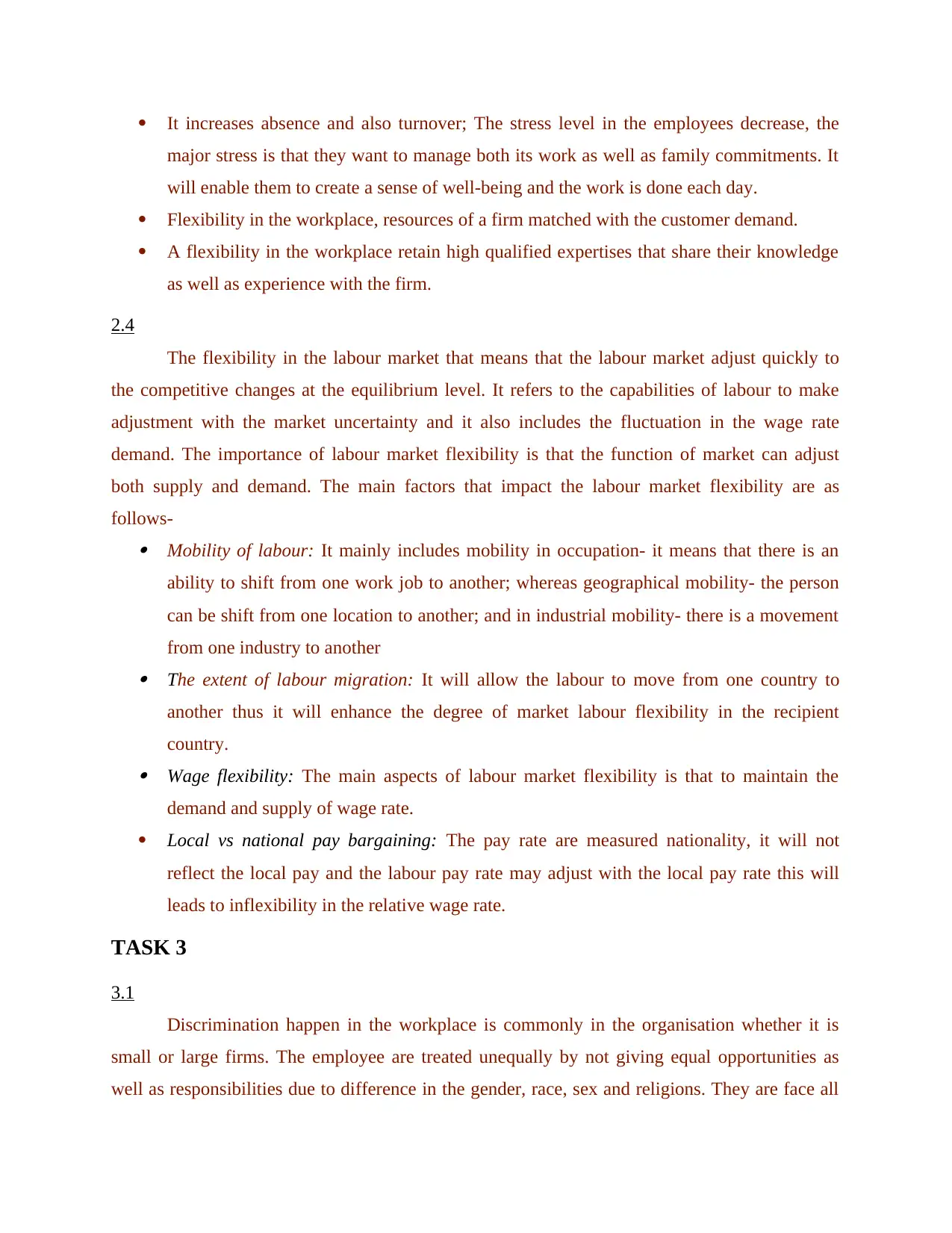
It increases absence and also turnover; The stress level in the employees decrease, the
major stress is that they want to manage both its work as well as family commitments. It
will enable them to create a sense of well-being and the work is done each day.
Flexibility in the workplace, resources of a firm matched with the customer demand.
A flexibility in the workplace retain high qualified expertises that share their knowledge
as well as experience with the firm.
2.4
The flexibility in the labour market that means that the labour market adjust quickly to
the competitive changes at the equilibrium level. It refers to the capabilities of labour to make
adjustment with the market uncertainty and it also includes the fluctuation in the wage rate
demand. The importance of labour market flexibility is that the function of market can adjust
both supply and demand. The main factors that impact the labour market flexibility are as
follows- Mobility of labour: It mainly includes mobility in occupation- it means that there is an
ability to shift from one work job to another; whereas geographical mobility- the person
can be shift from one location to another; and in industrial mobility- there is a movement
from one industry to another The extent of labour migration: It will allow the labour to move from one country to
another thus it will enhance the degree of market labour flexibility in the recipient
country. Wage flexibility: The main aspects of labour market flexibility is that to maintain the
demand and supply of wage rate.
Local vs national pay bargaining: The pay rate are measured nationality, it will not
reflect the local pay and the labour pay rate may adjust with the local pay rate this will
leads to inflexibility in the relative wage rate.
TASK 3
3.1
Discrimination happen in the workplace is commonly in the organisation whether it is
small or large firms. The employee are treated unequally by not giving equal opportunities as
well as responsibilities due to difference in the gender, race, sex and religions. They are face all
major stress is that they want to manage both its work as well as family commitments. It
will enable them to create a sense of well-being and the work is done each day.
Flexibility in the workplace, resources of a firm matched with the customer demand.
A flexibility in the workplace retain high qualified expertises that share their knowledge
as well as experience with the firm.
2.4
The flexibility in the labour market that means that the labour market adjust quickly to
the competitive changes at the equilibrium level. It refers to the capabilities of labour to make
adjustment with the market uncertainty and it also includes the fluctuation in the wage rate
demand. The importance of labour market flexibility is that the function of market can adjust
both supply and demand. The main factors that impact the labour market flexibility are as
follows- Mobility of labour: It mainly includes mobility in occupation- it means that there is an
ability to shift from one work job to another; whereas geographical mobility- the person
can be shift from one location to another; and in industrial mobility- there is a movement
from one industry to another The extent of labour migration: It will allow the labour to move from one country to
another thus it will enhance the degree of market labour flexibility in the recipient
country. Wage flexibility: The main aspects of labour market flexibility is that to maintain the
demand and supply of wage rate.
Local vs national pay bargaining: The pay rate are measured nationality, it will not
reflect the local pay and the labour pay rate may adjust with the local pay rate this will
leads to inflexibility in the relative wage rate.
TASK 3
3.1
Discrimination happen in the workplace is commonly in the organisation whether it is
small or large firms. The employee are treated unequally by not giving equal opportunities as
well as responsibilities due to difference in the gender, race, sex and religions. They are face all
⊘ This is a preview!⊘
Do you want full access?
Subscribe today to unlock all pages.

Trusted by 1+ million students worldwide
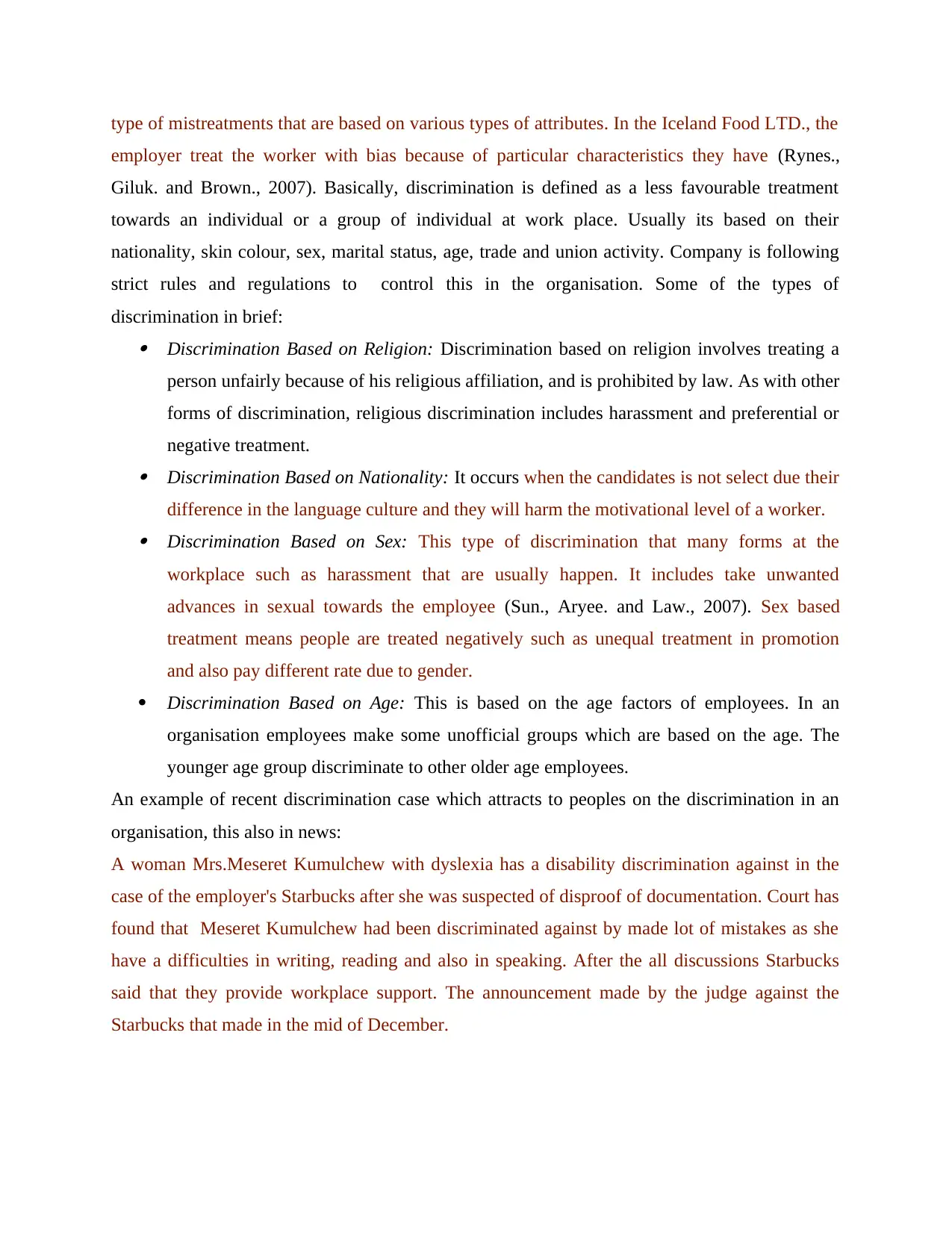
type of mistreatments that are based on various types of attributes. In the Iceland Food LTD., the
employer treat the worker with bias because of particular characteristics they have (Rynes.,
Giluk. and Brown., 2007). Basically, discrimination is defined as a less favourable treatment
towards an individual or a group of individual at work place. Usually its based on their
nationality, skin colour, sex, marital status, age, trade and union activity. Company is following
strict rules and regulations to control this in the organisation. Some of the types of
discrimination in brief: Discrimination Based on Religion: Discrimination based on religion involves treating a
person unfairly because of his religious affiliation, and is prohibited by law. As with other
forms of discrimination, religious discrimination includes harassment and preferential or
negative treatment. Discrimination Based on Nationality: It occurs when the candidates is not select due their
difference in the language culture and they will harm the motivational level of a worker. Discrimination Based on Sex: This type of discrimination that many forms at the
workplace such as harassment that are usually happen. It includes take unwanted
advances in sexual towards the employee (Sun., Aryee. and Law., 2007). Sex based
treatment means people are treated negatively such as unequal treatment in promotion
and also pay different rate due to gender.
Discrimination Based on Age: This is based on the age factors of employees. In an
organisation employees make some unofficial groups which are based on the age. The
younger age group discriminate to other older age employees.
An example of recent discrimination case which attracts to peoples on the discrimination in an
organisation, this also in news:
A woman Mrs.Meseret Kumulchew with dyslexia has a disability discrimination against in the
case of the employer's Starbucks after she was suspected of disproof of documentation. Court has
found that Meseret Kumulchew had been discriminated against by made lot of mistakes as she
have a difficulties in writing, reading and also in speaking. After the all discussions Starbucks
said that they provide workplace support. The announcement made by the judge against the
Starbucks that made in the mid of December.
employer treat the worker with bias because of particular characteristics they have (Rynes.,
Giluk. and Brown., 2007). Basically, discrimination is defined as a less favourable treatment
towards an individual or a group of individual at work place. Usually its based on their
nationality, skin colour, sex, marital status, age, trade and union activity. Company is following
strict rules and regulations to control this in the organisation. Some of the types of
discrimination in brief: Discrimination Based on Religion: Discrimination based on religion involves treating a
person unfairly because of his religious affiliation, and is prohibited by law. As with other
forms of discrimination, religious discrimination includes harassment and preferential or
negative treatment. Discrimination Based on Nationality: It occurs when the candidates is not select due their
difference in the language culture and they will harm the motivational level of a worker. Discrimination Based on Sex: This type of discrimination that many forms at the
workplace such as harassment that are usually happen. It includes take unwanted
advances in sexual towards the employee (Sun., Aryee. and Law., 2007). Sex based
treatment means people are treated negatively such as unequal treatment in promotion
and also pay different rate due to gender.
Discrimination Based on Age: This is based on the age factors of employees. In an
organisation employees make some unofficial groups which are based on the age. The
younger age group discriminate to other older age employees.
An example of recent discrimination case which attracts to peoples on the discrimination in an
organisation, this also in news:
A woman Mrs.Meseret Kumulchew with dyslexia has a disability discrimination against in the
case of the employer's Starbucks after she was suspected of disproof of documentation. Court has
found that Meseret Kumulchew had been discriminated against by made lot of mistakes as she
have a difficulties in writing, reading and also in speaking. After the all discussions Starbucks
said that they provide workplace support. The announcement made by the judge against the
Starbucks that made in the mid of December.
Paraphrase This Document
Need a fresh take? Get an instant paraphrase of this document with our AI Paraphraser
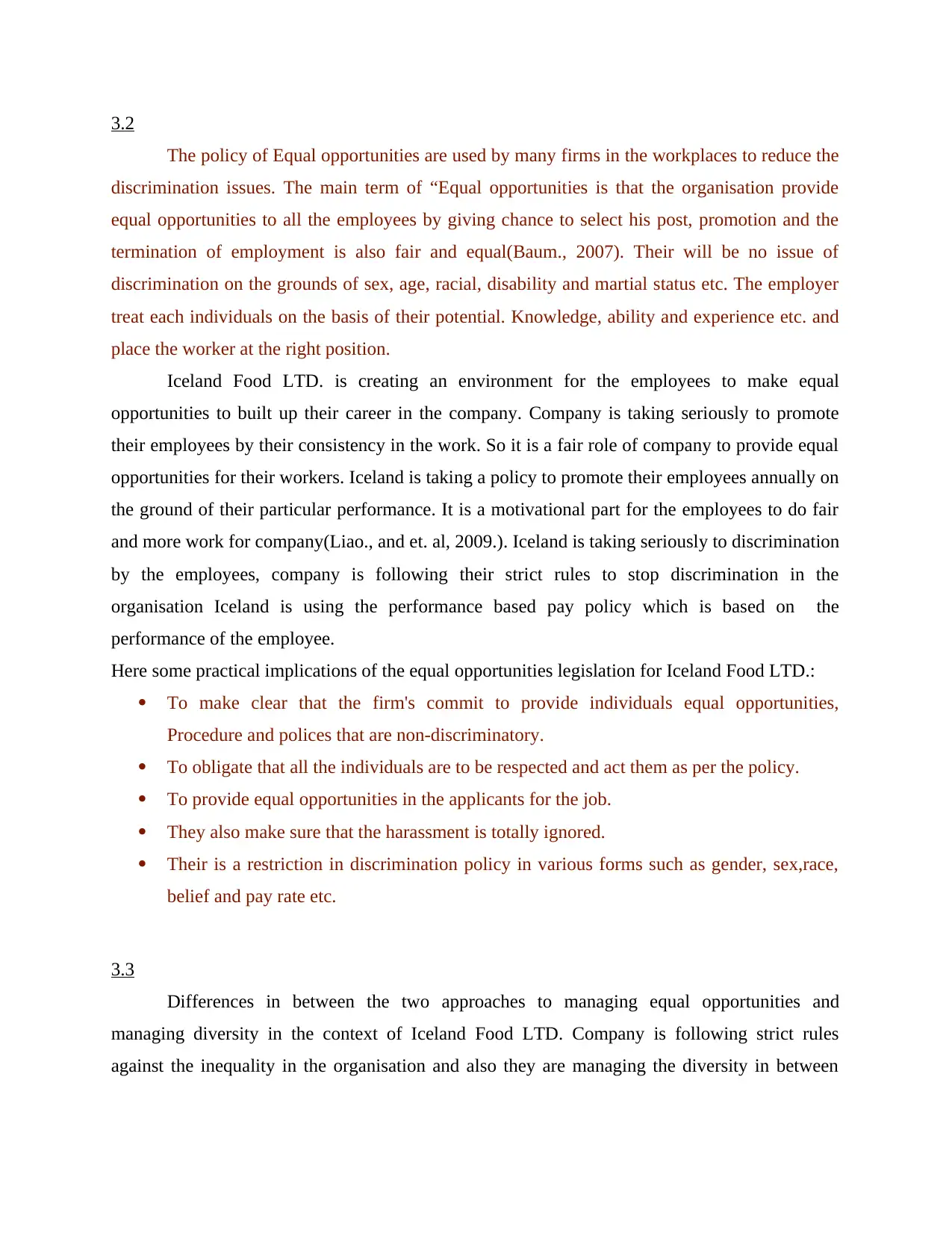
3.2
The policy of Equal opportunities are used by many firms in the workplaces to reduce the
discrimination issues. The main term of “Equal opportunities is that the organisation provide
equal opportunities to all the employees by giving chance to select his post, promotion and the
termination of employment is also fair and equal(Baum., 2007). Their will be no issue of
discrimination on the grounds of sex, age, racial, disability and martial status etc. The employer
treat each individuals on the basis of their potential. Knowledge, ability and experience etc. and
place the worker at the right position.
Iceland Food LTD. is creating an environment for the employees to make equal
opportunities to built up their career in the company. Company is taking seriously to promote
their employees by their consistency in the work. So it is a fair role of company to provide equal
opportunities for their workers. Iceland is taking a policy to promote their employees annually on
the ground of their particular performance. It is a motivational part for the employees to do fair
and more work for company(Liao., and et. al, 2009.). Iceland is taking seriously to discrimination
by the employees, company is following their strict rules to stop discrimination in the
organisation Iceland is using the performance based pay policy which is based on the
performance of the employee.
Here some practical implications of the equal opportunities legislation for Iceland Food LTD.:
To make clear that the firm's commit to provide individuals equal opportunities,
Procedure and polices that are non-discriminatory.
To obligate that all the individuals are to be respected and act them as per the policy.
To provide equal opportunities in the applicants for the job.
They also make sure that the harassment is totally ignored.
Their is a restriction in discrimination policy in various forms such as gender, sex,race,
belief and pay rate etc.
3.3
Differences in between the two approaches to managing equal opportunities and
managing diversity in the context of Iceland Food LTD. Company is following strict rules
against the inequality in the organisation and also they are managing the diversity in between
The policy of Equal opportunities are used by many firms in the workplaces to reduce the
discrimination issues. The main term of “Equal opportunities is that the organisation provide
equal opportunities to all the employees by giving chance to select his post, promotion and the
termination of employment is also fair and equal(Baum., 2007). Their will be no issue of
discrimination on the grounds of sex, age, racial, disability and martial status etc. The employer
treat each individuals on the basis of their potential. Knowledge, ability and experience etc. and
place the worker at the right position.
Iceland Food LTD. is creating an environment for the employees to make equal
opportunities to built up their career in the company. Company is taking seriously to promote
their employees by their consistency in the work. So it is a fair role of company to provide equal
opportunities for their workers. Iceland is taking a policy to promote their employees annually on
the ground of their particular performance. It is a motivational part for the employees to do fair
and more work for company(Liao., and et. al, 2009.). Iceland is taking seriously to discrimination
by the employees, company is following their strict rules to stop discrimination in the
organisation Iceland is using the performance based pay policy which is based on the
performance of the employee.
Here some practical implications of the equal opportunities legislation for Iceland Food LTD.:
To make clear that the firm's commit to provide individuals equal opportunities,
Procedure and polices that are non-discriminatory.
To obligate that all the individuals are to be respected and act them as per the policy.
To provide equal opportunities in the applicants for the job.
They also make sure that the harassment is totally ignored.
Their is a restriction in discrimination policy in various forms such as gender, sex,race,
belief and pay rate etc.
3.3
Differences in between the two approaches to managing equal opportunities and
managing diversity in the context of Iceland Food LTD. Company is following strict rules
against the inequality in the organisation and also they are managing the diversity in between
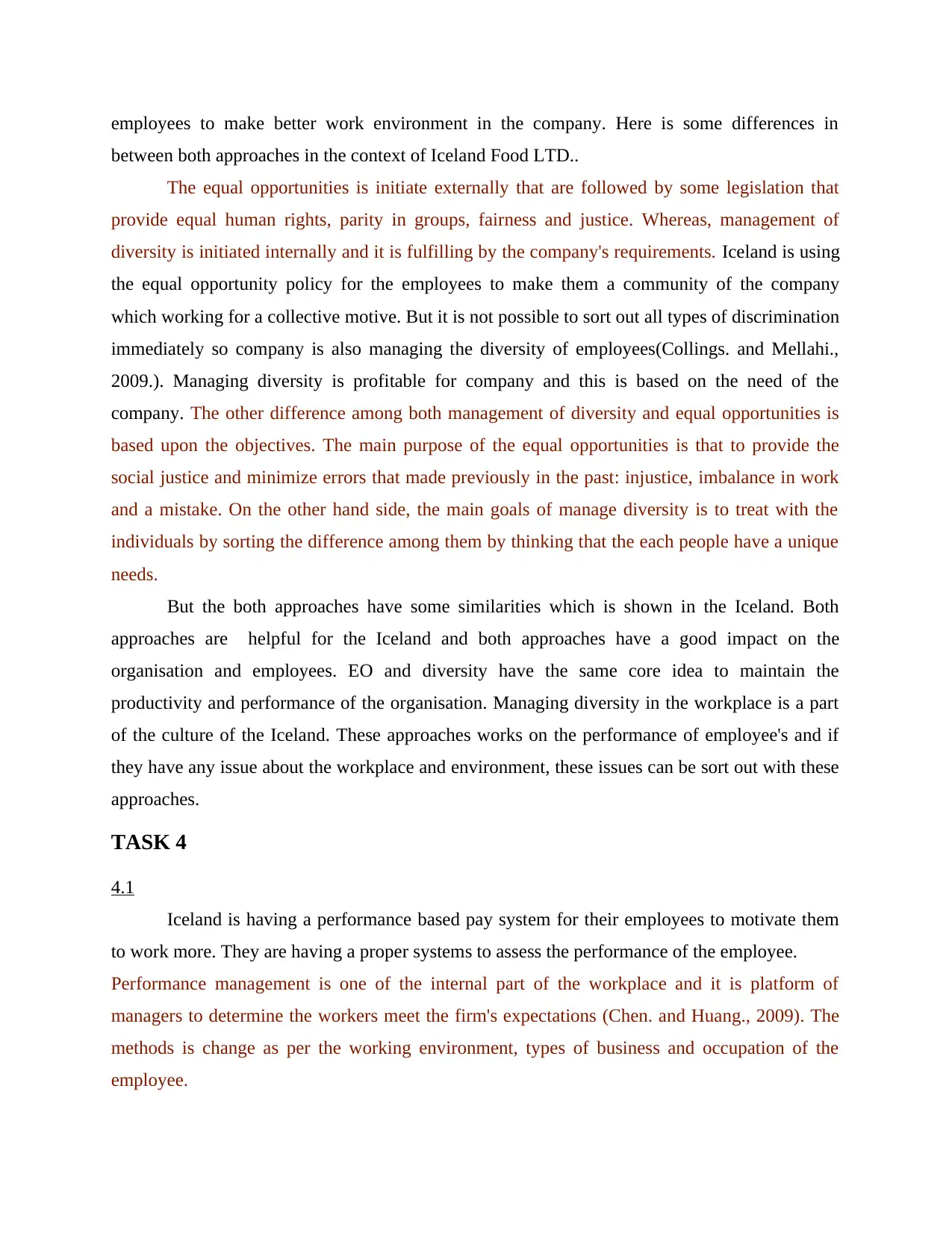
employees to make better work environment in the company. Here is some differences in
between both approaches in the context of Iceland Food LTD..
The equal opportunities is initiate externally that are followed by some legislation that
provide equal human rights, parity in groups, fairness and justice. Whereas, management of
diversity is initiated internally and it is fulfilling by the company's requirements. Iceland is using
the equal opportunity policy for the employees to make them a community of the company
which working for a collective motive. But it is not possible to sort out all types of discrimination
immediately so company is also managing the diversity of employees(Collings. and Mellahi.,
2009.). Managing diversity is profitable for company and this is based on the need of the
company. The other difference among both management of diversity and equal opportunities is
based upon the objectives. The main purpose of the equal opportunities is that to provide the
social justice and minimize errors that made previously in the past: injustice, imbalance in work
and a mistake. On the other hand side, the main goals of manage diversity is to treat with the
individuals by sorting the difference among them by thinking that the each people have a unique
needs.
But the both approaches have some similarities which is shown in the Iceland. Both
approaches are helpful for the Iceland and both approaches have a good impact on the
organisation and employees. EO and diversity have the same core idea to maintain the
productivity and performance of the organisation. Managing diversity in the workplace is a part
of the culture of the Iceland. These approaches works on the performance of employee's and if
they have any issue about the workplace and environment, these issues can be sort out with these
approaches.
TASK 4
4.1
Iceland is having a performance based pay system for their employees to motivate them
to work more. They are having a proper systems to assess the performance of the employee.
Performance management is one of the internal part of the workplace and it is platform of
managers to determine the workers meet the firm's expectations (Chen. and Huang., 2009). The
methods is change as per the working environment, types of business and occupation of the
employee.
between both approaches in the context of Iceland Food LTD..
The equal opportunities is initiate externally that are followed by some legislation that
provide equal human rights, parity in groups, fairness and justice. Whereas, management of
diversity is initiated internally and it is fulfilling by the company's requirements. Iceland is using
the equal opportunity policy for the employees to make them a community of the company
which working for a collective motive. But it is not possible to sort out all types of discrimination
immediately so company is also managing the diversity of employees(Collings. and Mellahi.,
2009.). Managing diversity is profitable for company and this is based on the need of the
company. The other difference among both management of diversity and equal opportunities is
based upon the objectives. The main purpose of the equal opportunities is that to provide the
social justice and minimize errors that made previously in the past: injustice, imbalance in work
and a mistake. On the other hand side, the main goals of manage diversity is to treat with the
individuals by sorting the difference among them by thinking that the each people have a unique
needs.
But the both approaches have some similarities which is shown in the Iceland. Both
approaches are helpful for the Iceland and both approaches have a good impact on the
organisation and employees. EO and diversity have the same core idea to maintain the
productivity and performance of the organisation. Managing diversity in the workplace is a part
of the culture of the Iceland. These approaches works on the performance of employee's and if
they have any issue about the workplace and environment, these issues can be sort out with these
approaches.
TASK 4
4.1
Iceland is having a performance based pay system for their employees to motivate them
to work more. They are having a proper systems to assess the performance of the employee.
Performance management is one of the internal part of the workplace and it is platform of
managers to determine the workers meet the firm's expectations (Chen. and Huang., 2009). The
methods is change as per the working environment, types of business and occupation of the
employee.
⊘ This is a preview!⊘
Do you want full access?
Subscribe today to unlock all pages.

Trusted by 1+ million students worldwide
1 out of 18
Related Documents
Your All-in-One AI-Powered Toolkit for Academic Success.
+13062052269
info@desklib.com
Available 24*7 on WhatsApp / Email
![[object Object]](/_next/static/media/star-bottom.7253800d.svg)
Unlock your academic potential
Copyright © 2020–2025 A2Z Services. All Rights Reserved. Developed and managed by ZUCOL.





